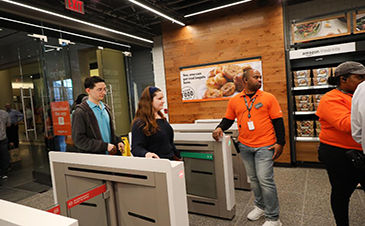If consumers can get what they need from the convenience store and leave without contacting the cashier, how cool is that?
Since 2015, Amazon has been trying this idea. It is now ready to open a retail store in Seattle, promising to provide convenient online shopping in the real world.
For a technology that most people are familiar with but not thinking about, this will be a huge win.
Go Grocery is a store created by Amazon for people in a hurry. This is a 10,400 square foot store with department stores, baked goods, agricultural products, beverages and easy-to-cook meals.
This is a small, centralized grocery store that consumers can find in the corner of city blocks. In addition to the Amazon brand, the uniqueness of this store also lies in the convenience of its new era.
Amazon is known for its customer service, which has helped this online retailer become one of the most trusted and loved brands in the United States.
Store managers understand that consumers do not want to understand the technology, they just want the problem to be solved. Consumers want convenience, and this is what they get in the Amazon store.
The customer enters Go Grocery, scans the QR code connected to their Amazon account, selects the required items, and then leaves. All payment details and product tracking are processed in the background through a cloud-based payment infrastructure and a large number of cameras.
Amazon said that self-driving cars use the same types of technology (including machine vision, sensor fusion, and deep learning), making it possible to realize the “Just Walk Out” shopping experience.
This way of shopping is too cool, but what if consumers do n’t shop on Amazon? Other retail business models are trying to use RFID to replicate this experience.
RFID tags have been in existence since they were invented by Harry Stockman in 1948. Today, from subway passes to livestock tracking, micro RFID tags are widely used.
RFID tags can be attached to product labels and stickers because of their small size. It is superior to simple bar codes because many RFID tags can be scanned at the same time. These tags are also very effective in inventory management systems.
Avery Dennison is known for manufacturing labels used in the consumer goods and packaging industries. Recently, the California-based company has actively expanded its RFID business.
In November last year, it acquired Smartrac, the world’s largest RFID tag inlay manufacturer. A month later, Avery Dennison broke ground on its new manufacturing plant in Brazil. Avery Dennison currently holds more than 1,000 RFID patents and fully utilizes its relationship with leading consumer brands.
In November 2019, Avery Dennison began a pilot project in collaboration with Ralph Lauren. According to a report published by Women’s Wear Daily, all labels printed on shirts, pants and other clothing will contain a electronic label. These tags provide a digital identity for clothing, which can track inventory and provide better after-sales service.
The advantages of RFID also make it suitable for convenience stores. Items can be marked and read in batches. This means retailers only need to scan once to know exactly how many items are on the shelves. This reduces the labor costs associated with inventory counting and repackaging.
Amazon wins online retail business through contactless shopping. And Avery Denison is manufacturing digital products to enable contactless shopping in the real world.
文章
In the 1998 foreign media magazine, Chris Hook, Strategy Manager of TIRIS Department of Texas Instruments and Equipment Corporation, published an article entitled “The Nature and Development of Smart Labels”, expounding the nature and development of smart labels. He defines “smart tags” as: Radio Frequency Identification (RFID) devices are designed to securely identify and track a wide range of commodity categories in the commercial and foreign markets, and export logistics information to a common thin and light On the label. “Smart” refers to the layered data embedded in the label printing material during the label production process, so that the label has new features, such as non-contact, non-line-of-sight reading and design programming, dynamic data storage, and instant and effective intercommunication with other similar labels. The ability of information.
Perhaps from this point on, when it comes to smart tags, the first thing people think of is RFID tags.
RFID is the abbreviation of Radio Frequency Identification (RFID) technology. According to the data, RFID technology originated in the United Kingdom, and its technical basis is radar technology. It was first used in the second world war to identify the enemy and the enemy in air operations. At that time, the United Kingdom used RFID technology to confirm whether the incoming aircraft was a self-propelled aircraft to avoid accidental strikes. The basic system configuration of this technique includes a transmitter, a receiver and a corresponding antenna. Now, the RFID transmitter is replaced by a tag, the receiver evolves into an RFID tag reader, and the antenna is built into the tag.
In fact, RFID was originally set up as an electronic product that is completely different from the traditional label, but was given the definition of the shape and label of the tag (in English, the term used in RFID tags is tag, and Not the label of the label). But the label industry is an industry full of enthusiasm for new things. This label-like electronic product quickly attracted the attention of the label industry and applied it to the manufacture of labels, making it a breakthrough in the era of intelligentization.
At the beginning of the birth, the application of RFID was limited to the military. According to the data, since the 1990s, this technology has been widely used by the US military in weapons and logistics management systems. The United States used RFID in the “Iraq War” to deploy weapons and materials very precisely to ensure the accurate supply of front-line ammunition and materials. The US military, which tasted the sweetness, stipulated in 2005 that all military supplies used RFID tags. This is actually a form of combining RFID technology with tags.
The application in the civil field is currently known to date back to the 1960s. However, at that time, although some people applied the technology to the commercial field, the application was very narrow, and it was only experimental, far from being a large-scale application. In the 1980s and 1990s, with the maturity of related technologies, Europe took the lead in enabling RFID technology in highway toll systems. This is the first time that the technology has been scaled up in the civilian market. The first to apply RFID technology to the retail industry is Wal-Mart. After the widespread use of RFID tags in malls and warehouse distribution centers, the shortage of Wal-Mart goods and the short-term out-of-stocks of goods have been greatly reduced, greatly increasing consumer satisfaction.
In the 21st century, with the breakthrough of international standardization of RFID technology, the application of RFID has also ushered in a new stage. In the fields of retail, road toll, logistics, cargo tracking, access control, parking management, identification, aviation, etc., the application of RFID technology is more and more extensive; in addition, in some reports, RFID is also applied in production automation. The industrial practical case; and one of the cases I personally experienced was the discovery of RFID tags on a very expensive foreign original book purchased.
If you only say RFID, you may feel too abstract and have no concept, but if you talk about ETC automatic payment on China’s expressway, ID card for everyone, card swipe during community security patrol, baggage check bag when flying, etc. I believe that everyone is certainly no stranger, and these are specific application examples of RFID technology.
The biggest feature of RFID technology is the recognition function, which can make each item have its own unique identification feature by means of the storage function of the label itself. The identification of the tagged item can be completed by reading the information stored in the RFID tag through the reader. RFID technology has made outstanding contributions to improving the anti-counterfeiting, anti-counterfeiting and anti-smuggling properties of products.


